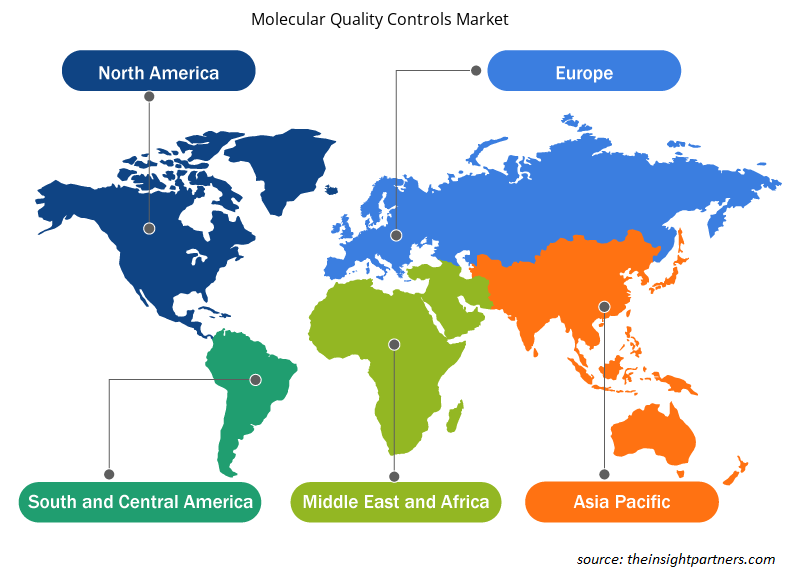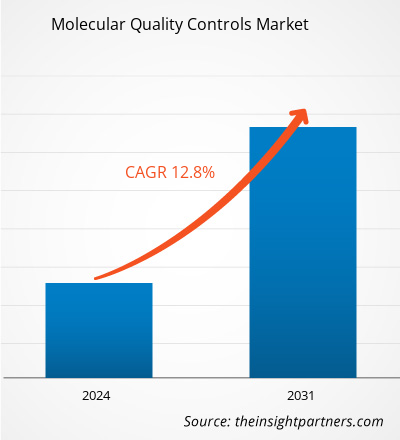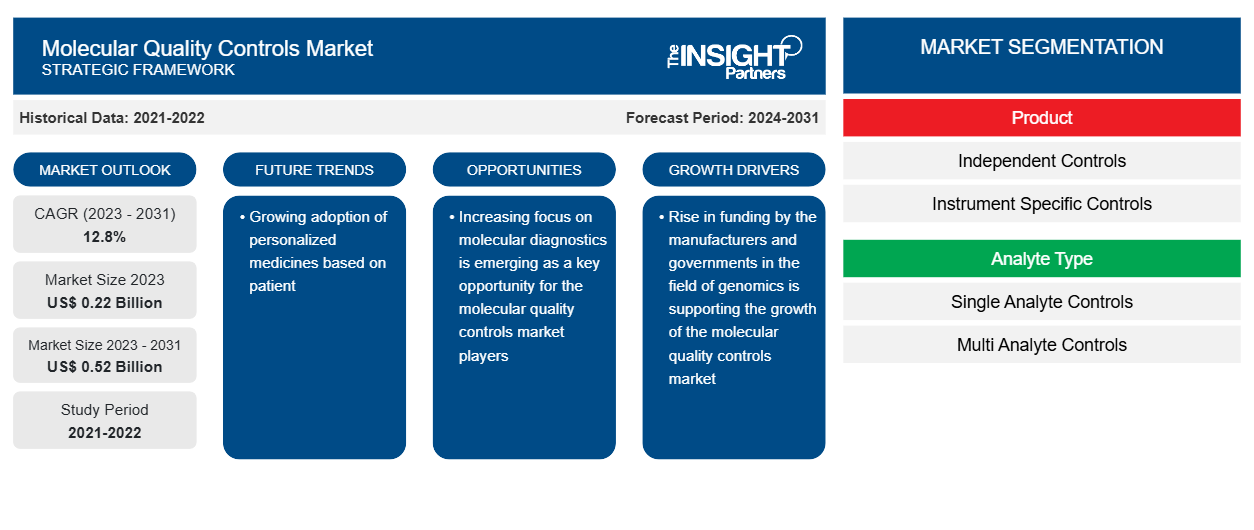分子质量控制市场规模预计将从 2023 年的 2.2 亿美元增至 2031 年的 5.2 亿美元。预计 2023-2031 年期间市场复合年增长率将达到 12.8%。个性化医疗需求的不断增长可能仍将是市场的主要趋势。
分子质量控制市场分析
基因组学资金不断增长以及遗传疾病患病率不断上升等因素推动了市场的增长。此外,对分子诊断的关注度不断提高,这成为分子质量控制市场参与者的关键机遇。
分子质量控制市场概况
几年前,基因组测序还仅限于研究机构。然而,它现在已成为临床实践中的标准技术之一。根据“将基因组学融入医疗保健”的研究,未来几年,医疗保健行业预计将生成超过 6000 万患者的基因组数据。医疗保健系统中基因组测序的不断实施得到了政府大量投资的支持,至少有 14 个国家的政府投资总额超过 40 亿美元。英国宣布了世界上最大的基因组项目,这是慈善组织和制药公司之间 2 亿美元公私合作的一部分。
定制此报告以满足您的需求
您可以免费定制任何报告,包括本报告的部分内容、国家级分析、Excel 数据包,以及为初创企业和大学提供优惠和折扣
-
获取此报告的关键市场趋势。这个免费样品将包括数据分析,从市场趋势到估计和预测。
分子质量控制市场驱动因素和机遇
遗传病患病率不断上升
由于分子质量控制有助于解释结果,因此它们被用于检测遗传疾病。21 号染色体的额外完整或部分拷贝会导致异常细胞分裂,从而产生唐氏综合症这种遗传疾病。根据美国疾病控制和预防中心 (CDC) 的数据,美国每年约有 6,000 名婴儿患有唐氏综合症。因此,唐氏综合症的产前检测在全国范围内不断增加。
大多数遗传性乳腺癌病例中,BRCA1(乳腺癌基因一)和 BRCA2(乳腺癌基因二)两种基因发生突变。根据美国癌症协会的数据,从父母传给后代的缺陷基因占遗传性乳腺癌病例的 5% 至 10%。随着乳腺癌意识的增强,遗传性乳腺癌的基因检测变得越来越流行。
分子诊断应用率上升
分子诊断方法用于检测 DNA 或 RNA 中特定序列之间的异常。单核苷酸多态性 (SNP)、缺失、重排和插入等异常会导致各种疾病,例如传染病、癌症、病毒性疾病和性传播疾病 (STD)。
根据《流感事实和统计报告》,2017-2018年,因流感就诊的门诊人数约为3140万人次。报告还提到,每年有5-20%的美国人口患流感。此外,根据美国国家癌症研究所的数据,2020年,美国将诊断出约1,806,590例新癌症病例,预计死亡人数为606,520人。预计到2024年,癌症患者人数将上升到1900万人。传染病的高发病率和癌症发病率的不断上升,导致分子诊断受到高度关注,因为它能够以高特异性诊断疾病,为精准医疗治疗患者铺平了道路。
分子质量控制市场报告细分分析
有助于得出分子质量控制市场分析的关键部分是产品、应用和最终用户。
- 根据产品,分子质量控制市场细分为独立控制和仪器特定控制);分析物类型(单分析物控制和多分析物控制)。独立控制部分在 2023 年占据了最大的市场份额。
- 根据应用,分子质量控制市场分为传染病、肿瘤学、基因检测和其他应用。传染病领域在 2023 年占据了最大的市场份额。
- 根据最终用户,分子质量控制市场分为临床实验室、医院、体外诊断制造商和合同研究组织、学术和研究机构、其他最终用户。临床实验室部分在 2023 年占据了最大的市场份额。
分子质量控制市场份额按地区分析
分子质量控制市场报告的地理范围主要分为五个区域:北美、亚太、欧洲、中东和非洲、南美和中美。
在北美,美国是最重要的分子质量控制市场。制造公司以及学术和研究机构在开发癌症药物、不断增长的老龄人口、传染病和其他治疗方法方面的投资和资金不断增加是主要驱动因素之一。
人们普遍认为,基于 NGS 的诊断将在未来指导治疗选择,以改善患者的治疗效果。根据美国国家癌症研究所的数据,预计 2020 年美国将诊断出 1,806,590 例新癌症病例,其中 606,520 人死于癌症。同样,根据白血病和淋巴瘤协会 (LLS) 的数据,预计 2020 年美国将有 178,520 人被诊断出患有白血病、淋巴瘤或骨髓瘤。因此,上述因素将在预测的时间范围内推动市场增长。
分子质量控制市场区域洞察
Insight Partners 的分析师已详尽解释了预测期内影响分子质量控制市场的区域趋势和因素。本节还讨论了北美、欧洲、亚太地区、中东和非洲以及南美和中美洲的分子质量控制市场细分和地理位置。

- 获取分子质量控制市场的区域特定数据
分子质量控制市场报告范围
| 报告属性 | 细节 |
|---|---|
| 2023 年的市场规模 | 2.2亿美元 |
| 2031 年市场规模 | 5.2亿美元 |
| 全球复合年增长率(2023 - 2031) | 12.8% |
| 史料 | 2021-2022 |
| 预测期 | 2024-2031 |
| 涵盖的领域 |
按产品
|
| 覆盖地区和国家 |
北美
|
| 市场领导者和主要公司简介 |
|
分子质量控制市场参与者密度:了解其对业务动态的影响
分子质量控制市场正在快速增长,这得益于终端用户需求的不断增长,而这些需求又源于消费者偏好的不断变化、技术进步以及对产品优势的认识不断提高等因素。随着需求的增加,企业正在扩大其产品范围,进行创新以满足消费者的需求,并利用新兴趋势,从而进一步推动市场增长。
市场参与者密度是指在特定市场或行业内运营的企业或公司的分布情况。它表明在给定市场空间中,相对于其规模或总市场价值,有多少竞争对手(市场参与者)存在。
在分子质量控制市场运营的主要公司有:
- 赛默飞世尔科技股份有限公司
- 诺斯泰斯
- BIO-RAD 实验室公司
- F.霍夫曼拉罗什有限公司
- 雅培、Quidel 公司
- 缅因分子控制有限公司
免责声明:上面列出的公司没有按照任何特定顺序排列。

- 了解分子质量控制市场顶级关键参与者概况
分子质量控制市场新闻和最新发展
分子质量控制市场通过收集一级和二级研究后的定性和定量数据进行评估,其中包括重要的公司出版物、协会数据和数据库。分子质量控制市场的一些发展如下所列:
- 雅培和 Personalis, Inc. 已达成合作协议,开发和分销用于下一代测序 (NGS) 研究的液体活检对照品。此次合作的目的是提高液体活检程序在检测和追踪癌症方面的精确度和可靠性。(来源:雅培,公司网站,2024 年 5 月)
- Qiagen 称,现已推出针对巨细胞病毒、乙肝病毒 (HBV) 和 SARS-CoV-2 的新型 QuantiTect 病毒载量控制。这些控制满足了临床环境中对准确病毒感染监测日益增长的需求。(来源:Qiagen,公司网站,2024 年 1 月)
分子质量控制市场报告覆盖范围和交付成果
“分子质量控制市场规模和预测(2021-2031)”报告对以下领域进行了详细的市场分析:
- 范围内涵盖的所有关键细分市场的全球、区域和国家层面的分子质量控制市场规模和预测
- 分子质量控制市场趋势以及市场动态,如驱动因素、限制因素和关键机遇
- 详细的 PEST/波特五力分析和 SWOT 分析
- 分子质量控制市场分析涵盖主要市场趋势、全球和区域框架、主要参与者、法规和最新的市场发展。
- 行业格局和竞争分析,涵盖市场集中度、热图分析、知名参与者以及分子质量控制市场的最新发展
- 详细的公司简介
- 历史分析(2 年)、基准年、预测(7 年)及复合年增长率
- PEST和SWOT分析
- 市场规模、价值/数量 - 全球、区域、国家
- 行业和竞争格局
- Excel 数据集
近期报告
客户评价
购买理由
- 明智的决策
- 了解市场动态
- 竞争分析
- 客户洞察
- 市场预测
- 风险规避
- 战略规划
- 投资论证
- 识别新兴市场
- 优化营销策略
- 提升运营效率
- 顺应监管趋势























 获取免费样品 - 分子质量控制市场
获取免费样品 - 分子质量控制市场